Health and nutrition apps take up about 29.4% of the overall app market, according to Statista. They’re even more popular than dating apps, and take the next place after banking apps.
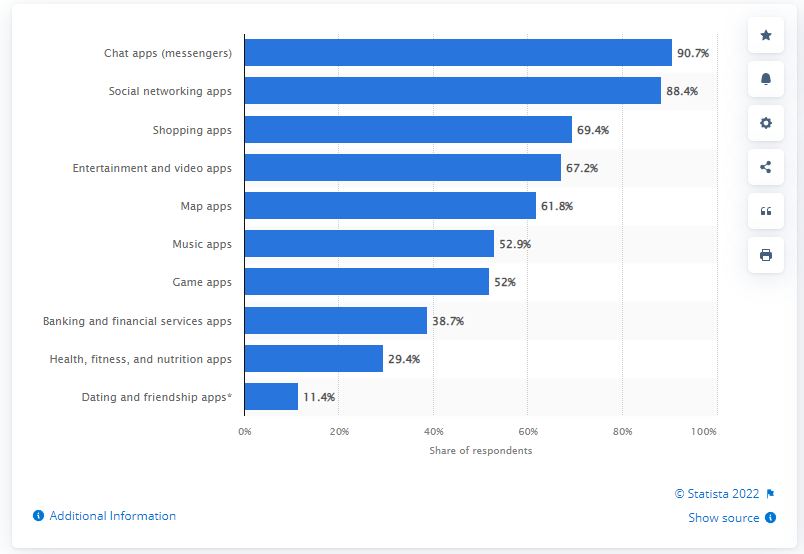
Most popular app categories worldwide during 3rd quarter 2020, by reach (according to Statista).
By October 2020, users have downloaded diet and nutrition apps 111 million times. That’s a 47% year-over-year download growth. As you can see, people need nutrition apps like air — and now is a great time to create your own. But before you make up an app idea, let’s figure out what makes a nutrition app, and who’s the target audience of these apps (‘cause this is the most important).What is a nutrition app?
Diet apps are applications that help users monitor nutrition, follow a diet, manage weight and do fitness. They are also used by people with allergies, diabetes, and heart and stomach diseases. Basically, a nutrition app can include anything associated with food, eating habits, health, and fitness.That’s how these apps usually work:
- user registers and answers questions about their weight, height, habits, and others;
- the app calculates a nutrition plan for the user;
- every day the user enters their meals and exercises in the app;
- the app calculates calories, so the user sees whether they meet the plan.
Who needs nutrition apps?
To select features for your future app, you need to understand your target audience. Do you want to help people with diabetes and know the nuances of such diets? Or maybe you want to help people gain muscle mass faster and more efficiently? Answer these questions and you will set the direction of your application. This will help you plan the design, structure, and marketing strategy of your application.At the same time, do not forget about statistics — you need to understand why people download nutrition apps. According to the survey, aside from wanting to maintain a healthy diet, many Americans have specific dietary requirements. About 30% of them have specific diets, 20% have food sensitivities, and 5% have food allergies. Appropriate nutritional information may not always be available, so nutrition apps can be really helpful.
Types of nutrition apps
There are several types of existing nutrition applications. However, you can combine these types and create an app that includes all kinds of features — it all depends on your business goals.🔴 Calorie counters — these apps allow users to count the calories of their meals, track their daily plan, check the caloric value of different foods, and more. An example of such an app is MyFitnessPal.
🔴 Meal planners — these apps create diet charts for users for a day, week, or month according to the given data. They can suggest what to eat for breakfast, lunch, dinner, and even for a snack. Diet Assistant is such an app.
🔴 Recipe apps — recipe apps users get to choose the best meals according to their food preferences and health and fitness goals. The main premise of these mobile products is to educate users on how to cook healthy meals.
🔴 Special diet tracking apps — these apps are focused on a narrow audience — people with specific tastes or diets. Users of such apps can be vegetarians, pregnant, or suffering from diabetes. An example of such an app is Klinio.
🔴 Wager apps — such apps allow users to bet money on reaching their weight goals within a certain period. If the goal is achieved, the user gets the money back; otherwise, the money goes to the app. DietBet is an example of a wager app.
Trends and must-haves in nutrition mobile app development
Here we collected a list of features crucial for making a nutrition app, as well as some thoughts on how to make them better. Plus, we added some trends that will help you stand out from the competitors.⚫️ Registration and onboarding
When a user registers, the app needs to collect data from them — their age, current weight and height, lifestyle, habits, goals, and more. Our recommendation is to make the registration process as simple and intuitive as possible. Plus, don’t forget to give users the ability to choose a system of measurement, especially if you target a broad audience.The imperial system might be comfortable for US and UK users, but don’t forget that most other countries use the metric system.
During onboarding, you can ask as many questions as it’s needed to give the user a personalized diet plan. Of course, all these questions should be based on nutrition expertise. Inspire by market leaders, and check how they onboard users.
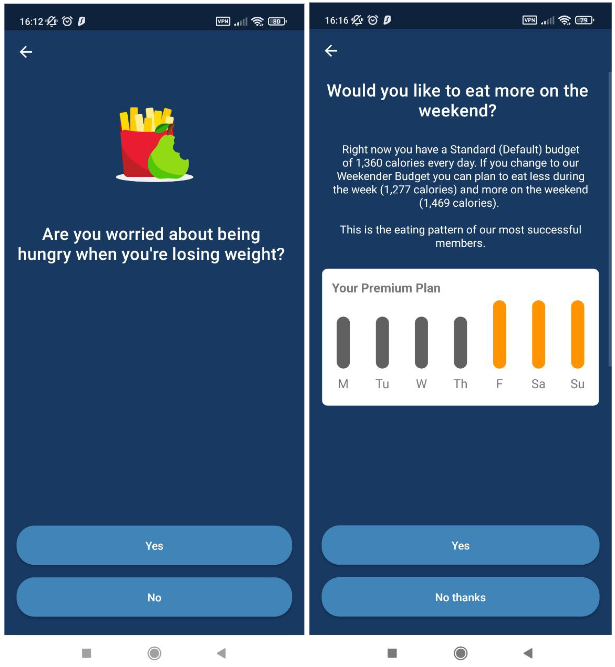
Here are some onboarding questions from Lose It! app.
⚫️ Barcode scanner
This is an absolute must-have for all calorie-counting and meal-planning apps. Barcode scanner allows users to add meals quickly by scanning barcodes on the products they ate. It’s inconvenient to count calories in your head — just scan the chocolate you ate and count the calories automatically.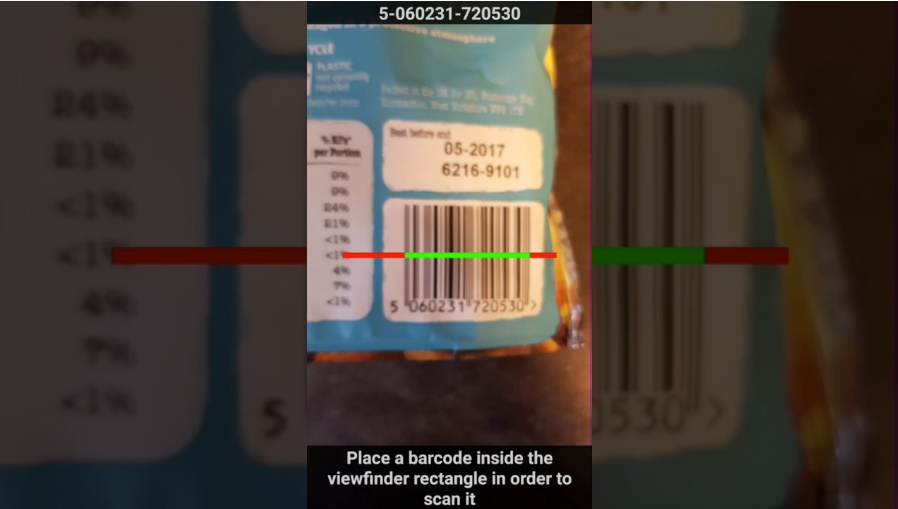
An example of barcode scanner.
⚫️ Integration with devices
A lot of people that try to lose weight or just stay healthy, wear fitness trackers, smart watchers, and more. If you want to make a nutrition app, you need to give users the ability to connect these devices to your app. This way, they’ll be able to keep all exercise data in one place and check how many calories they burned.⚫️ Diet plan
Based on the user’s answers during the registration, you can give them a personalized diet plan. You need to recommend to them how many calories, carbs, fats, and protein they need to consume daily to lose or gain weight.⚫️ Gamification
Gamification allows users to become more immersed in the application and helps to achieve goals. You can give users rewards for completed exercises or for following a plan for several days.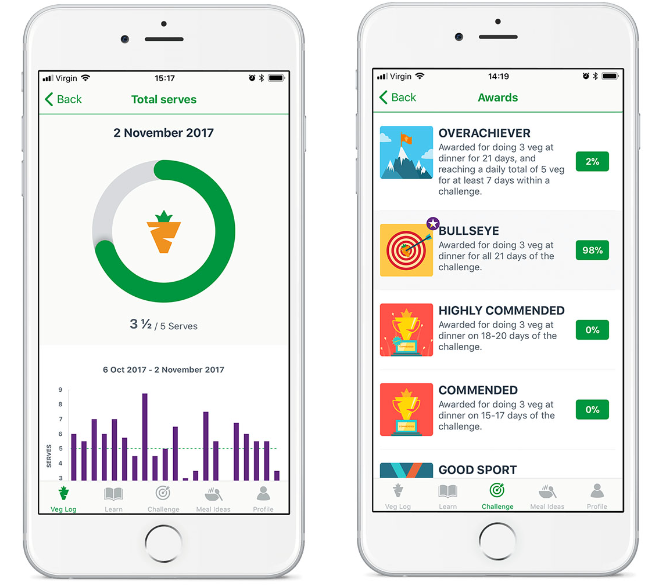
An example of gamification.
⚫️ Shopping list
This feature helps users to make a shopping list based on the calorie content of products. Instead of scanning barcodes on products in the store, the user can immediately decide at home what they will eat for dinner, and then calmly buy everything in the store. And you can also integrate your nutrition app with a delivery application so that users can order the necessary products from home.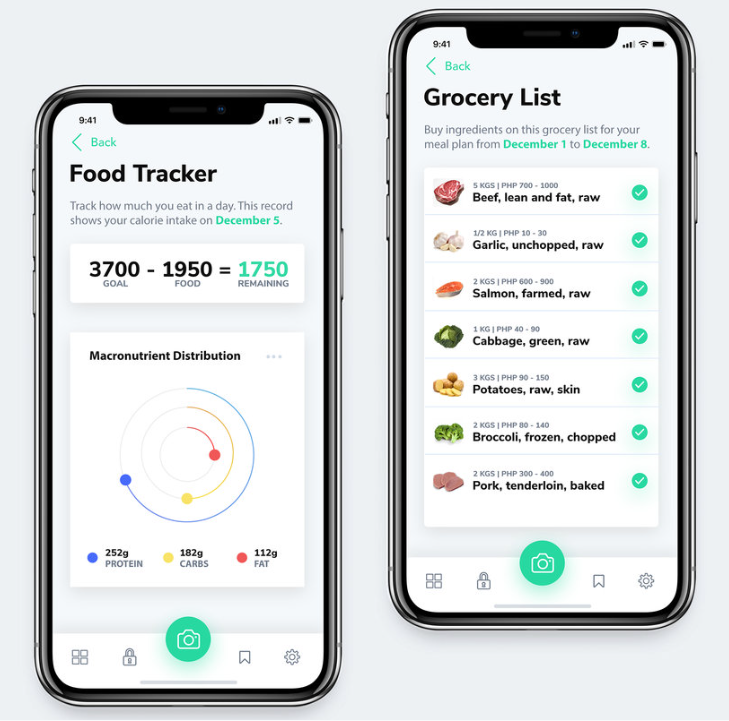
An example of a shopping list.
⚫️ Computer vision
Computer vision will help to recognize the user’s products and show the approximate calorie content. This is much faster and more convenient than scanning barcodes, especially since not all products have them — for example, a banana. At the moment, there are no applications in which this feature is implemented well, so you can be the first 😉.By the way, at Brivian, we are experienced in creating computer vision modules and systems, thus we can help you with implementing this feature. Feel free to contact us through the form either here or below the text.
Choosing a tech stack
Before you start choosing a contractor and developing the app, you need to decide on the platform on which you want to release the application — iOS or Android. You can choose one or both at once, but you need to understand that the timing and cost will depend on it.There are two main ways to develop a mobile application — native and cross-platform methods. In the case of native development, we use “mother” languages for each platform. It’s Kotlin for Android and Swift for iOS. As for cross-platform development, we use the React Native framework, which allows us to make one application that will work on both platforms.
At first glance, it seems that it’s better to choose cross-platform development — it really has some advantages. It’s cheaper and takes less time since we develop only one application, and thus you can kill two birds with one stone. But there are also disadvantages — this method is less reliable and allows you to implement fewer functions than the native one. The native application will be more productive, compact, and modern. In addition, the native application can access smartphone components directly, such as a camera, microphone, fingerprint recognition module, etc. A cross-platform application needs to use workarounds to access these components, so these functions work worse in it. How to choose the method?
Our advice is here: if you just need to test a business idea and quickly launch an application with only basic functions, cross-platform development is suitable for you. It’s also a good idea to go native but start with one platform because you can always develop the second application later. If you want a reliable application with high performance and you have long-term prospects, then only the native method is suitable here.
How much does it cost to create a nutrition app?
Each development company has different prices for services, and the cost of the application depends on the specialists’ hourly rates, the number of functions, as well as the selected tech stack.At Brivian, cross-platform mobile app development with React Native costs from $30.000 and takes about 3 months for an MVP, while native development costs from $45.000 and takes about 4 months.
Of course, this estimation is rough — if you wish to have a precise estimate, please fill in the form either here or below and our manager will get in touch with you soon.